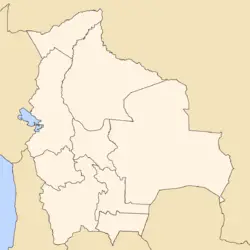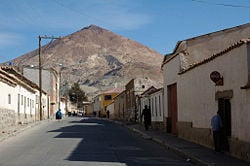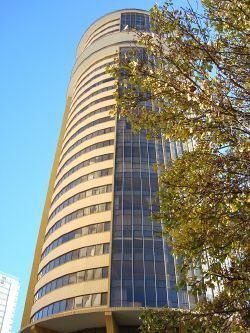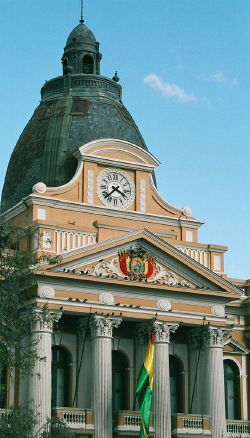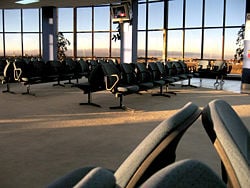La Paz
| La Paz Nuestra Señora de La Paz |
|||
| La Paz skyline | |||
|
|||
| Motto: "Los discordes en concordia, en paz y amor se juntaron y pueblo de paz fundaron para perpetua memoria" | |||
| Location of La Paz within Bolivia | |||
| Coordinates: 16°30′S 68°09′W | |||
|---|---|---|---|
| Country | |||
| Departament | La Paz Department (Bolivia) | ||
| Province | Pedro Domingo Murillo Province | ||
| Founded | October 20 1548 | ||
| Incorporated (El Alto) | 20th century | ||
| Government | |||
| - Mayor | Juan Del Granado | ||
| Area | |||
| - Total | 470 km² (181.5 sq mi) | ||
| Elevation | 3,640 m (11,942 ft) | ||
| Population (2008[1]) | |||
| - Total | 877,363 | ||
| - Density | 6,275.16/km² (16,252.6/sq mi) | ||
| Area code(s) | 2 | ||
| Website: www.ci-lapaz.gov.bo/ | |||
Nuestra Señora de La Paz is the administrative capital of Bolivia, as well as the departmental capital of La Paz Department.
La Paz is the highest capital city in the world, and is home to the world's highest golf course, football stadium, velodrome (where the world record currently stands), and landing strip.
La Paz is renowned for its unique markets, unusual topography, and traditional culture.
Geography
The full name of the city was Nuestra Señora de La Paz, meaning "Our Lady of Peace", commemorating the restoration of peace following the insurrection of Gonzalo Pizarro and fellow conquistadors in 1544. The city is also known as Chuquiago Marka, or Chuqiyapu from Aymara. "Chuqi" means "gold", and "yapu" means "farm".
Located 42 miles (68km) southeast of Lake Titicaca, La Paz, which is at an elevation of between 10,650 and 13,250 feet (3250 and 4100 metres) above sea level, is the world’s highest national capital.
La Paz is close to the famous mountains such as the Illimani (guardian of La Paz), Huayna Potosi, Mururata, and Illampu. On the Western side of the Altiplano divide, about an hour to the west of the La Paz, is the site of the tallest mountain in Bolivia and ninth tallest mountain in the Andes, the Sajama Volcano.
La Paz was built in a canyon created by the Choqueyapu River (now mostly built over), which runs northwest to southeast. The city's main thoroughfare, which roughly follows the river, changes names over its length, but the central tree-lined section running through the downtown core is called the Prado.
The weather in La Paz is usually bright and sunny all year round. The high altitude means temperatures are consistently cool throughout the year, though the diurnal temperature variation is typically large. The average maximum daytime temperature in January of 77°F (25°C), dropping to an average maximum of around 71.6°F (22°C) in July. The city has a relatively dry climate, with rainfall occurring mainly in the slightly warmer months of November to March, when rain occurs in showers most afternoons. Average annual precipitation is 22.6 inches (575mm).
The industrial pollution of water supplies used for drinking and irrigation is an environmental issue.
La Paz' geography (in particular, altitude) reflects society: the lower (geographically) residents go, the more affluent. While many middle-class residents live in high-rise condos near the center, the houses of the truly affluent are located in the lower neighborhoods southwest of the Prado. And looking up from the center, the surrounding hills are plastered with makeshift brick houses of those of less economic fortune.
The satellite city of El Alto, in which the airport is located, is spread over a broad area to the west of the canyon, on the Altiplano.
History
While there is evidence that the Andean region was inhabited 10,000 years ago, from about 100 C.E., a major Indian civilization called the Tiwanaku culture developed at the southern end of Lake Titicaca, and built gigantic monuments and carved statues out of stone. However, their civilization declined rapidly during the 13th century, possibly due to an extended drought.
By the late 14th century, a warlike tribe called the Aymara controlled much of western Bolivia. The Inca Indians of Peru defeated the Aymara during the fifteenth century and made Bolivia part of their huge empire. They controlled the area until the Spanish conquest in 1538. The Incas generally forced their religion, customs, and language, Quechua, on their defeated rivals. But the Aymara resisted full assimilation, and maintained their separate language and many customs.
Pedro de la Gasca, the Spanish king had entrusted rule over the former Inca lands, commanded Captain Alonso de Mendoza to found a new city commemorating the end of the civil wars in Peru. Then the city of La Paz was founded on October 20th, 1548, as a commercial city, lying on the main gold and silver route to the coast. The Spaniards, who came for the gold found in the Choqueapu River that runs through La Paz, took the gold mines away from Aymara people and made them work as slaves. The primarily male Spanish population soon mixed with the indigenous people, creating a largely mestizo, or mixed, population.
In 1549, Juan Gutierrez Paniagua was commanded to design an urban plan that would designate sites for public areas, plazas, official buildings, and a cathedral. La Plaza de los Españoles, which is known today as the Plaza Murillo, was chosen as the location for government buildings as well as the Metropolitan Cathedral.
During most of the Spanish colonial period, Bolivia was a territory called "Upper Peru" or "Charcas" and was under the authority of the Viceroy of Lima. Local government came from the Audiencia de Charcas located in Chuquisaca (modern Sucre). Bolivian silver mines produced much of the Spanish empire's wealth. Spain controlled La Paz with a firm grip.
In 1781, for a total of six months, a group of Aymara people besieged La Paz. Under the leadership of Tupac Katari (1750–1781), they destroyed churches and government property. The siege was broken by colonial troops who advanced from Lima and Buenos Aires, and Tupac Katari was executed.
By 1800, La Paz had become the largest city of Upper Peru (the early name for Bolivia), acting as the center of population growth and agricultural production. The heavily populated Altiplano hinterland above La Paz fed its growth. Many large estate land holders, known as haciendados, lived in La Paz throughout most of the year while they maintained a small community of indigenous people to live and work on their haciendas (landed estates). Fine examples of old Spanish Colonial Architecture in houses is located close to the central plazas and offices of the city remain from this period.
As Spanish royal authority weakened during the Napoleonic wars, sentiment against colonial rule grew. Independence was proclaimed in 1809, but 16 years of struggle followed before the establishment of the republic, on August 6, 1825. The republic was named after Venezuelan general and leader of South American independence, Simón Bolívar (1783-1830).
In 1825, after the decisive victory of the republicans at Ayacucho over the Spanish army in the course of the South American Wars of Independence, the city's full name was changed to La Paz de Ayacucho (meaning The Peace of Ayacucho).
Simon Bolivar was the first president of the republic. The country was divided in five departments: La Paz, Cochabamba, Potosí, Charkas and Santa Cruz de la Sierra.
By 1840, Bolivia started exporting more than it imported, allowing the government to invest in infrastructural. La Paz grew as the financial, commercial, and political capital of the area. But La Paz was isolated by poor roads and the lack of rail lines leading over the harsh Altiplano to ports in Peru and Chile.
Bolivia's military weakness was demonstrated during the War of the Pacific (1879–1883), when it lost its seacoast and the adjoining rich nitrate fields to Chile. An increase in the world price of silver brought Bolivia a measure of relative prosperity and political stability in the late 1800s.
In 1898, La Paz was made the de facto seat of the national government, with Sucre remaining the nominal historical as well as judiciary capital. This change reflected the shift of the Bolivian economy away from the largely exhausted silver mines of Potosí to the exploitation of tin near Oruro, and resulting shifts in the distribution of economic and political power among various national elites.[2]
Construction began, in 1900, on the international railroad network linking La Paz to the Pacific and Atlantic coasts, thus solidifying the future role of La Paz as a primary city.
The first oil company came to Bolivia in 1921. Bolivia was found to have great reservoirs of oil, in addition to it's precious minerals.
A succession of governments, espousing laissez-faire capitalist policies, was controlled by an economic and social elite that did little to create an economy based on genuine production of goods and services. Rather, they acquired wealth by controlling and selling natural resources. The living conditions of the indigenous people, who constituted most of the population, remained deplorable. Forced to work under primitive conditions in the mines almost like slaves, they were denied access to education, economic opportunity, or political participation.
In 1932, Bolivia and Paraguay fought over ownership of the Gran Chaco, a large lowland plain bordering the two countries thought to be rich in oil. Bolivia was defeated in 1935 and eventually gave up most of the disputed land. Some years later it was found that there were no oil resources in the Chaco.
The disastrous Chaco War led to growing dissatisfaction with the ruling elite, resulting in the emergence of the Nationalist Revolutionary Movement, a broadly based left-wing party. Denied victory in the 1951 presidential elections, in 1952 the Nationalist Revolutionary Movement led a successful revolution. Under President Víctor Paz Estenssoro, the Nationalist Revolutionary Movement introduced universal adult suffrage, carried out a sweeping land reform, promoted rural education, and nationalized the country's largest tin mines. This in turn sparked a great growth spurt in La Paz, as many working-class and poor migrated to urban areas.
In the mid-1960s, Che Guevara (1928–1967), a Cuban communist leader and colleague of Fidel Castro, tried to mount another revolution in Bolivia. But the very Bolivian peasantry, whom he had come to liberate, betrayed him to Bolivian troops, who killed him on October 9, 1967.
From 1964 through to the 1970s, control of the Bolivian government changed hands repeatedly, mostly after revolts by rival military officers. Alarmed by public disorder, the military, the Nationalist Revolutionary Movement, and others installed Colonel (later General) Hugo Banzer Suárez (1926–2002) as president in 1971. Banzer ruled with Nationalist Revolutionary Movement support from 1971 to 1978. The economy expanded and grew impressively during most of Banzer's presidency, but human rights violations and eventual fiscal crises undercut his support. He was forced to call new elections in 1978, and Bolivia once again entered a period of political turmoil.
Successive elections in the 1970s led to coups, counter-coups, and caretaker governments. In the 1985, 1989, 1993, 1997, and 2002 presidential elections, no candidate won a majority of the popular vote.
By the end of the 20th century, inflation had been brought under control, the economy was growing faster than the regional average, and the Bolivian peso, renamed the boliviano, was stabilized.
Hugo Banzer was chosen to serve as president again in 1997. At the outset of his government, Banzer launched a policy of using special police units to physically eradicate Bolivia's illegal coca. The policy produced a sudden and dramatic four-year decline in Bolivia's illegal coca crop to the point that Bolivia became a relatively small supplier of coca for cocaine. Those left unemployed by coca eradication streamed into the cities, especially El Alto the slum neighbor of La Paz, exacerbating social tensions and giving rise to a new indigenous political movement.
In 2002, Gonzalo Sánchez de Lozada (born 1930) again became president. In October 2003, Sánchez resigned after two months of rioting and strikes over a gas-exporting project that protesters believed would benefit foreign companies more than Bolivians.
On December 18, 2005, Evo Morales (born 1959), illegal-coca agitator and indigenous leader of the Movement Towards Socialism party, was elected to the presidency by 54 percent of the voters, an unprecedented absolute majority in Bolivian elections. Morales pledged to nationalize hydrocarbons and alleviate poverty and discrimination towards indigenous Bolivians. During his campaign, Morales promised to exert more government control over natural gas reserves and to re-examine the current coca eradication programs.
Government
Bolivia is a republic. The president, who is both chief of state and head of government, is elected by popular vote for a single five-year term. The bicameral National Congress, or Congreso Nacional, consists of Chamber of Senators of 27 members elected by proportional representation from party lists to serve five-year terms, and a Chamber of Deputies of 130 members, 70 of whom are directly elected from their districts and 60 are elected by proportional representation from party lists, all to serve five-year terms.
Bolivia is divided into nine departments, which are further divided into 100 provinces. The provinces are each divided into municipalities and cantons, which handle local affairs. The city of La Paz is capital of the La Paz department.
Bolivia has had a total of 193 coups d'état from independence until 1981, thereby averaging a change of government once every 10 months. Credit for the past quarter century of relative political stability is largely attributed to President Víctor Paz Estenssoro, who ceded power peacefully after cutting hyperinflation which reached as high as 14,000 percent.
Economy
Bolivia is one of the poorest and least developed countries in Latin America. Following an economic crisis during the early 1980s, reforms spurred private investment, stimulated economic growth, and cut poverty rates in the 1990s. Political instability, racial tensions, and violent protests against plans - subsequently abandoned - to export Bolivia's newly discovered natural gas reserves to large northern hemisphere markets, characterized the period from 2003 to 2005. In 2005, the government passed a controversial hydrocarbons law that imposed higher royalties and required foreign firms to surrender all production to the state energy company, which was made the sole exporter of natural gas.
Per capita GDP was estimated at $4400 in 2007.
During a long period of high inflation and economic struggle in the 1980s and early 1990s, a large informal economy developed. Almost every street in the downtown area and surrounding neighborhoods has at least one vendor on it.
About two-thirds of Bolivia's manufacturing is located in and around La Paz. Food stuffs, tobacco products, clothing, various consumer goods, building materials, and agricultural tools are produced, mostly in small plants.
Railways and highways connect La Paz with Peruvian and Chilean seaports and with Argentina and Brazil. La Paz Bus Station, previously bus and train station, is the main gateway for intercity bus travel in La Paz, and connects the city with Santiago, Chile, and Lima, Peru. El Alto International Airport is located eight miles (14km) south-west of La Paz, above the city on the plateau.
Demographics
The city of La Paz had a population of 877,363 in 2008, and together with the neighboring cities of El Alto and Viacha, make the biggest urban area of Bolivia, with a population of over 1.6 million inhabitants. Quechua made up 30 percent of Bolivia's population in 2001, mestizo (mixed white and Amerindian ancestry) 30 percent, Aymara 25 percent, and white 15 percent.
Spanish, spoken by 60.7 percent of Bolivia's population in 2001, was an official language of Bolivia, along with Quechua 21.2 percent, and Aymara 14.6 percent. Foreign languages were spoken by 2.4 percent, other 1.2 percent. Roman Catholics made up 95 percent of Bolivia's population, and Protestants (Evangelical Methodist) 5 percent.
The University of San Andrés, founded in 1830, and the Bolivian Catholic University, founded in 1966, are located in La Paz.
Of interest
La Paz is the cultural center of Bolivia. The city is located near numerous ancient ruins, especially the Tiahuanacu ruins, which are thousands of years older than Macchu Picchu in Peru. Another day trip visit tourists usually include is the Lake Titicaca and the lakeside city of Copacabana (its Cathedral is visited by many Bolivians to see the Virgen de Copacabana figure, deity of the Lake). Sites of interest include:
- The Cathedral of San Francisco, named after the founder Francisco de los Angeles Morales, whose remains are interred there. The Franciscans arrived in the Chuquiago valley before the founder of La Paz, Alonzo de Mendoza. Generous Cacique (chief) of Quirquincha gave them the land for construction of the monastery that remains the main attraction of La Paz.
- The San Francisco square, which is the busiest place of La Paz, with bus and taxi stops, souvenir street Sagarnaga, inexpensive snack-bars, and hundreds of little shops.
- The Metropolitan Cathedral, built in neoclassical style between 1835 and 1987, which is the location of the remains of the revolutionary leader Antonio José de Sucre (1795–1830).
- Calle Jaén, near the city center and Plaza Murrllo, is a charming colonial street where the buildings and cobblestoned street have been preserved, without traffic, is the location of 10 museums, including Museo Murillo, once owned by Pedro Domingo Murillo, a hero of the Bolivian republic, and the Museo de Litoral, which displays items from the War of the Pacific (1879-1884).
Also, the city is home to hundreds of museums. the Palacio Quemado (executive building), the Congress (which one may attend sometimes), the Valley of the Moon, the Cine-Teatro Municipal (built in the 19th century), the largest state University (Universidad Mayor de San Andres), the Cementerio General (where many of Bolivia's presidents are buried), the house of Simon Bolivar, the Devil's Tooth (geological formation, hiking site), and many more.
Supposable curses have been put on the land because of the disturbance in the ruins when Jose Galvaerio was murdered by Mateo Sanhosea.
La Paz is the home field of some of the biggest football teams in Bolivia.
- Club Bolivar. Founded in 1925 and trains and plays some home games at its stadium, Libertador Simon Bolivar.
- The Strongest. Founded in 1908 and hosts some of its games and trains on its home stadium, Rafael Mendoza.
- La Paz F.C..
However, both teams play the majority of their games in the city stadium, Estadio Hernando Siles. It is host to several other teams that play in the first and second divisions such as: Mariscal Braun (2nd), Always Ready (2nd), Municipal (2nd), Chaco (2nd), and Iberoamericana (2nd).
La Paz also hosts the national soccer team and a plethora of international games.
Looking to the future
Does the city face no challenges or offer up anything else as a legacy?"
Does the city need reconstruction?
Is it a model city?
Will it run out of water?
Does it have a crucial role to play in the nation?
Gallery
- LPB vista nocturna final.jpg
Nighttime View of La Paz
See also
- Cochabamba
- Sucre
- Santa Cruz de la Sierra
- El Alto
- Calacoto
- San Pedro prison
- La Paz F.C.
ReferencesISBN links support NWE through referral fees
- ↑ World Gazetteer
- ↑ [1] "La Paz," Microsoft® Encarta® Online Encyclopedia 2008. Retrieved November 10, 2008
External links
- Encyclopaedia Britannica La Paz Retrieved January 11, 2009.
- World Fact Book 2009 Bolivia Retrieved January 11, 2009.
- San Francisco Church, La Paz Retrieved January 11, 2009.
- Calle-Jaen street Retrieved January 11, 2009.
- Museums in La Paz
- Excursions in the surrounding of La Paz
- High Altitude Pathology Institute IPPA La Paz
- Bolivian Yellow Pages
- 17 pictures of La Paz
- The world's most dangerous road
- Biking on the ROAD OF DEATH
-
- Mapping from Multimap or GlobalGuide or Google Maps
- Satellite image from WikiMapia
- Mapping from OpenStreetMap
Asunción, Paraguay · Bogotá, Colombia · Brasília, Brasil · Buenos Aires, Argentina · Caracas, Venezuela · Cayenne, French Guiana · Georgetown, Guyana · Grytviken, South Georgia and the South Sandwich Islands · La Paz, Bolivia · Lima, Peru · Montevideo, Uruguay · Paramaribo, Suriname · Quito, Ecuador · Santiago, Chile · Sucre, Bolivia · Stanley, Falkland Islands
Credits
New World Encyclopedia writers and editors rewrote and completed the Wikipedia article in accordance with New World Encyclopedia standards. This article abides by terms of the Creative Commons CC-by-sa 3.0 License (CC-by-sa), which may be used and disseminated with proper attribution. Credit is due under the terms of this license that can reference both the New World Encyclopedia contributors and the selfless volunteer contributors of the Wikimedia Foundation. To cite this article click here for a list of acceptable citing formats.The history of earlier contributions by wikipedians is accessible to researchers here:
The history of this article since it was imported to New World Encyclopedia:
Note: Some restrictions may apply to use of individual images which are separately licensed.


